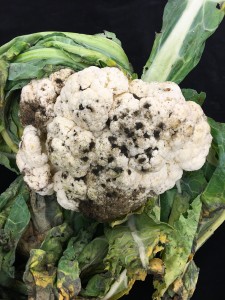We have received several samples of cauliflower in the last two weeks with black spots on the heads. These spots ranged from small pinpoint dots to larger circular spots up to several mm in diameter (Fig. 1). Many of the blighted curds also had light brown, soft, slimy spots, which often coalesced into larger zones
that penetrated well into the heads (Figs 2 and 3). The black spots were caused by either Alternaria brassicae or A. brassicicola. The lighter brown slimy spots were caused by the soft rot pathogen, Pectobacterium carotovorum subsp. carotovorum. Since Pectobacterium infects wounded or damaged plant tissues, it is likely that the soft rot occurred secondarily to the Alternaria infections, although soft rot may be found in the absence of Alternaria. Alternaria also causes round to ovoid bull’s eye lesions on leaves and stems of cauliflower. Yellowing of tissues surrounding the lesions, as well as leaf drop, may also occur. While Alternaria lesions generally do not progress deeply into the cauliflower head, they are unsightly and render the heads unmarketable. Secondary soft rot infections can cause significantly more damage to the heads than the initial Alternaria infection.
Alternaria brassicae and A. brassicicola can cause disease in any brassica (also called crucifers or cole crops), but not plants outside this family. They survive between seasons in crop debris and on seeds. They produce large amounts of spores that travel on the wind from plant to plant. Warm temperatures and high relative humidity favor disease development. It is important to adopt an integrated approach to managing this disease, focusing on clean seed, cultural practices and effective fungicides used in accordance with label requirements for resistance management.
- Buy certified disease-free seeds or treat seeds with hot water. Always check with your seed supplier to determine if seeds have already been hot water-treated. Some brassica seeds are routinely treated with hot water for black rot control. Seeds should never be hot water-treated more than once.
- Scout seedlings in the greenhouse or seedbed and remove those with symptoms.
- Rotate out of brassicas for several years to allow enough time for Alternaria inoculum loads in the soil to drop to low levels.
- Incorporate crop debris into soil to hasten decomposition.
- Do not maintain cull piles of brassicas – compost or bury culls to destroy Alternaria spores.
- Control weeds in the Brassica/Crucifer family.
- Manage irrigation to allow plants to dry before evening.
- Apply fungicides as suggested in the Midwest Vegetable Production Guide for Commercial Growers. Be sure to alternate fungicides with different modes of action to reduce the risk of fungicide resistance development.
Should cauliflower be sprayed now? It depends – if the weather will continue to be warm (60-78 F) in your area and you anticipate having the cauliflower crop in the field for a few weeks, it may be worth the cost of fungicides if the the disease is in the early stages. Most fungicides recommend beginning applications preventatively or when the disease first appears. Note that Preharvest Intervals (PHIs) range from 0 to 7 days for fungicides labeled for use on cauliflower.


